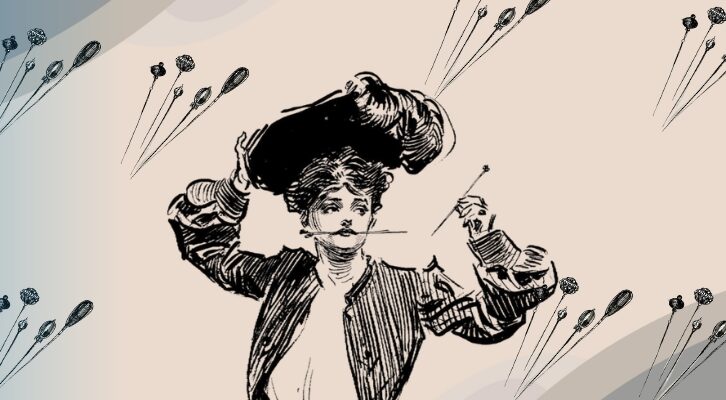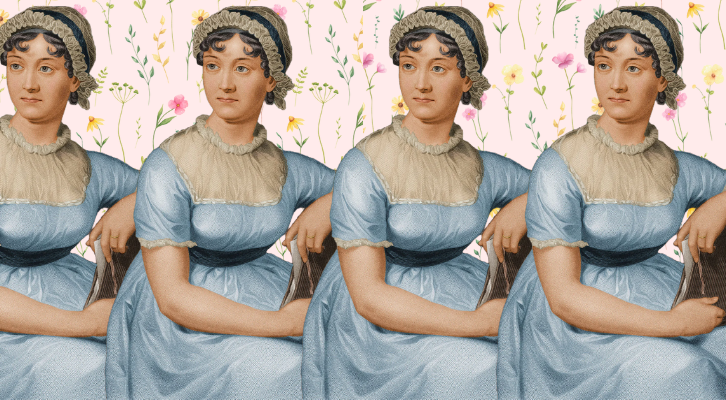
Jane Austen’s Many Literary Afterlives:
A Reading List
Rebecca Romney Recommends Edith Wharton, Vanessa Riley, Karen Joy Fowler and More
I have always loved Jane Austen, even though I have been very wrong about her. I remember the day I learned that Austen was not as original a writer as I had thought. I was reading a book called Evelina by Frances Burney. It was a novel Austen herself had read and loved: that’s why I had picked it up in the first place. Early in the book, the heroine goes to a ball where she meets the man who will become the hero.
But that will take some time: a friend overhears him calling Evelina “a poor weak girl” and informs her of the insult. In Pride and Prejudice (1813), the heroine Elizabeth Bennet experiences much the same mortification from overhearing Mr. Darcy at a ball. Today we associate that trope with Pride and Prejudice, but in Austen’s lifetime it was Evelina’s version that was far more famous.
As a rare book dealer, I understand the value of “firsts”: “the first edition”; “the first romance novel”; “the first great woman writer in English.” We value “firsts.” In the rare book marketplace, they translate to higher prices. But contrary to her popular reputation, Austen wasn’t the “first” of anything. She wasn’t the first author of courtship novels, or what we today call romance. Of her first published work, Sense and Sensibility (1811), one contemporary reviewer noted its lack of “newness.” Nor was she “the first great woman writer in English,” as one of her modern biographers called her. In the years when Austen was trying to publish, the most critically acclaimed novelist—not “woman novelist” but simply “novelist”—was Maria Edgeworth, another of Austen’s favorite authors.
This was one of the most exciting realizations I had while working on my book Jane Austen’s Bookshelf. Learning that Austen was working within an established tradition of courtship novels was thrilling: it meant that there were more great books for me to discover that Austen had read, loved, and been influenced by. Reading Austen’s favorite authors didn’t dim my appreciation for her. Austen’s greatness lies not in her originality, but in her skill. Her style speaks of discipline and confidence. It is refined yet, at times, cynical. It was in her execution that Austen became immortal.
This reading list offers six books that all owe a debt to Austen’s work. These books are not great because of that influence, but because of how they used it. Just as Austen learned from her literary models and adapted them to her purposes, each of these authors teased out threads from Austen in order to make something peculiarly their own.
In emphasizing particular aspects of Austen’s work that resonated with them, these authors engage with the richness of Austen’s novels. Are they masterful works of realism? Compelling social commentaries? Comforting happy endings? Transcendent pieces of timeless art? Cynical assessments of the regency marriage market? It depends on whom you ask.
*
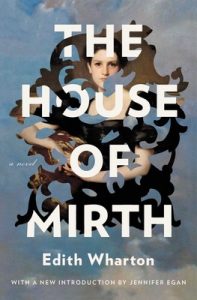
The House of Mirth by Edith Wharton
Austen wasn’t always the canonical icon we know her as today. Her focus on the ordinary lives of women was considered by many of her era too narrow a topic to be high art. But as the nineteenth century progressed and realism was championed by influential critics like William Dean Howells, Austen’s own reputation rose as well. The great social realists at the turn of the last century saw in Austen a model of how to depict the rich interiority of their characters through the everyday. In her The Writing of Fiction (1925), Edith Wharton chose Austen’s works as the ideal novels that are “preeminently of character […] ‘Emma’ is perhaps the most perfect example in English fiction of a novel in which character shapes events quietly but irresistibly.” That description could equally be attributed to Wharton’s own novel, House of Mirth, and its charismatic (anti-?)heroine Lily Bart.
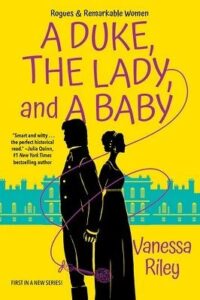
A Duke, The Lady, and a Baby by Vanessa Riley
Together with Georgette Heyer, Jane Austen is the primary inspiration for the subgenre of modern historical romance novels known as regency romances. These novels are set roughly between 1811 and 1820, the period when the eldest child of King George III acted as regent due to the king’s mental illness. After the sustained success of Heyer’s novels, publishers began issuing category lines of regency romances in the 1970s. The 1980s saw the trend grow with beloved authors like Judith McNaught producing single-title regency blockbusters, and the 1990s experienced its own rejuvenation of the genre with the work of Amanda Quick.
In every generation the genre has adapted itself to new tastes and perspectives, all the while holding to Austen as its most consistent touchstone.Regencies tend to prize wit and style, characteristics that stand out in especially vivid contrast within a historical setting defined by strict social limitations. Riley’s regency romance, which features a cross-dressing new mother as the heroine, offers a beautiful balance of cheekiness and social commentary.
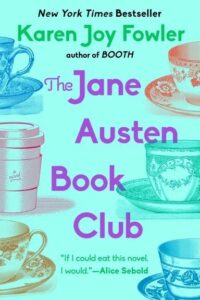
The Jane Austen Book Club by Karen Joy Fowler
Austen’s novels are so synonymous with the “comfort read” that they have taken on an even greater significance: they are viewed as symbols of why we read in the first place. As I discovered when reading Austen’s favorites in Jane Austen’s Bookshelf, this is fertile ground for memoir. But it also serves as the premise of a number of novels, a kind of commentary on novel reading itself. My favorite among these is Karen Joy Fowler’s The Jane Austen Book Club, which follows a group of friends who connect over their regular Austen reads. A novel about people who love to read novels? Austen would have loved such meta narratives. She wrote one herself: Northanger Abbey.

Pride, Prejudice, and Other Flavors by Sonali Dev
While Austen is associated with regencies—historical novels—she was, in fact, writing about her contemporaries. Sonali Dev has published an entire series of contemporary romances that are a particularly delightful example of that sub-sub-genre, Austen retellings (think Bridget Jones’s Diary). For instance, Pride, Prejudice, and Other Flavors also contains an early scene in which animosity sparks between the main characters through an overheard conversation.
Dev’s romance brings in Bollywood richness and glamor while also teasing out the themes of family connection that are the quiet heart of Austen’s Pride and Prejudice. While Dev employs tropes from Austen, she has created a unique hybrid of her influences—just as Austen did.
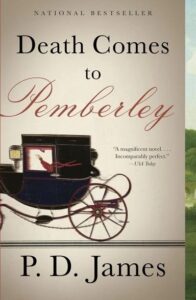
Death Comes to Pemberley by P.D. James
I could have created a list entirely of contemporary romance authors and it would have been a worthy homage to Austen’s influence, but the breadth of her reach is itself unusual. This murder mystery is an Austen pastiche, using the characters and setting of Austen’s novels, but with an entirely original story. It picks up a few years after Pride and Prejudice, when George Wickham is accused of murder.
James named Austen among the authors of whom she can “detect the influence […] in my own work.” James appreciated Austen’s lurking cynicism, which proved excellent inspiration for a murder mystery in James’s own style. James disliked Austen’s overly saccharine reputation, which she thought unmerited. As James recorded in her diary: “‘Her sweetness of temper never failed,’ wrote her nephew James Edward Austen-Leigh. On the contrary, it failed frequently, and if it hadn’t we would not have had six great novels.”
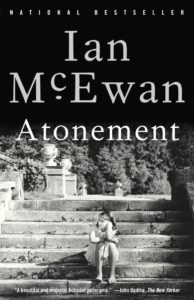
Atonement by Ian McEwan
Part of Austen’s modern appeal—the reason she is one of the most commonly read “classic” authors—is because her work pleases readers across today’s fractured genre landscape. Austen has a devoted following among romance readers. She also attracts admirers who don’t read romance at all.
Often cited as one of the greatest English novels of the past one hundred years, Atonement pulls inspiration primarily from Northanger Abbey. In both novels, a young girl’s literary turn of mind exacerbates her naive errors, complicating our conceptions of imagination and reality, dreaming and consequences. In an interview about Atonement, Ian McEwan made clear his debt to her: “The ghost that stalks this novel is that of Jane Austen.”
__________________________________

Jane Austen’s Bookshelf: A Rare Book Collector’s Quest to Find the Women Writers Who Shaped a Legend by Rebecca Romney is available from Marysue Rucci Books/S&S.
Rebecca Romney
Rebecca Romney is a rare book dealer and the cofounder of Type Punch Matrix, a rare book company based in Washington, DC. She is the rare books specialist on the HISTORY Channel’s show Pawn Stars, and the cofounder of the Honey & Wax Book Collecting Prize. She is a generalist rare book dealer, handling works in all fields, from first editions of Jane Austen to science fiction paperbacks. Romney is the author of Printer’s Error: Irreverent Stories from Book History (with JP Romney) and The Romance Novel in English: A Survey in Rare Books, 1769–1999. Her work as a bookseller or writer has been featured in The New York Times, The Atlantic, Forbes, Variety, The Paris Review, and more. In 2019, she was featured in the documentary on the rare book trade, The Booksellers. She is on the Board of the Antiquarian Booksellers’ Association of America (ABAA) and the faculty of the Antiquarian Book Seminar (CABS-Minnesota).











